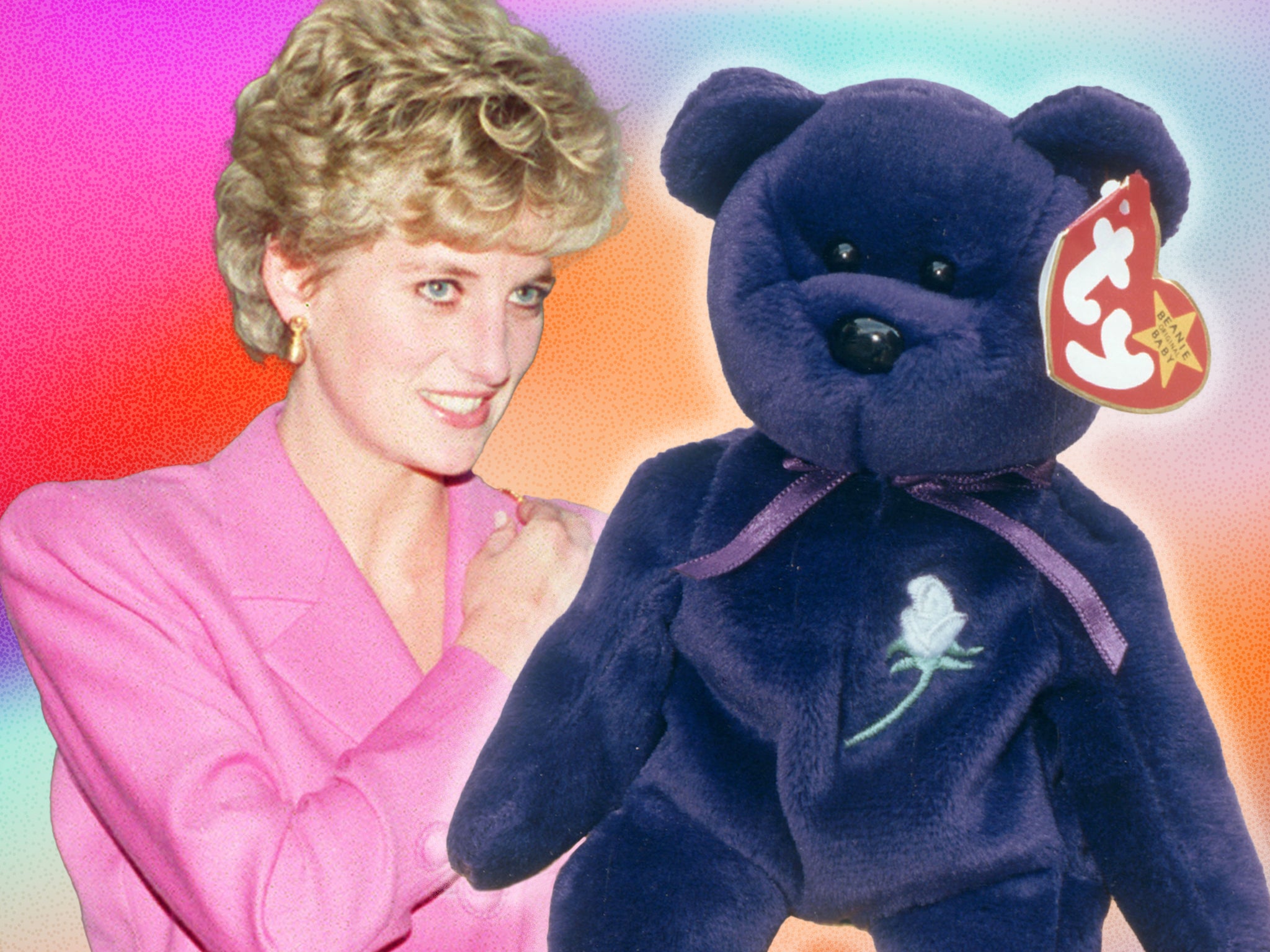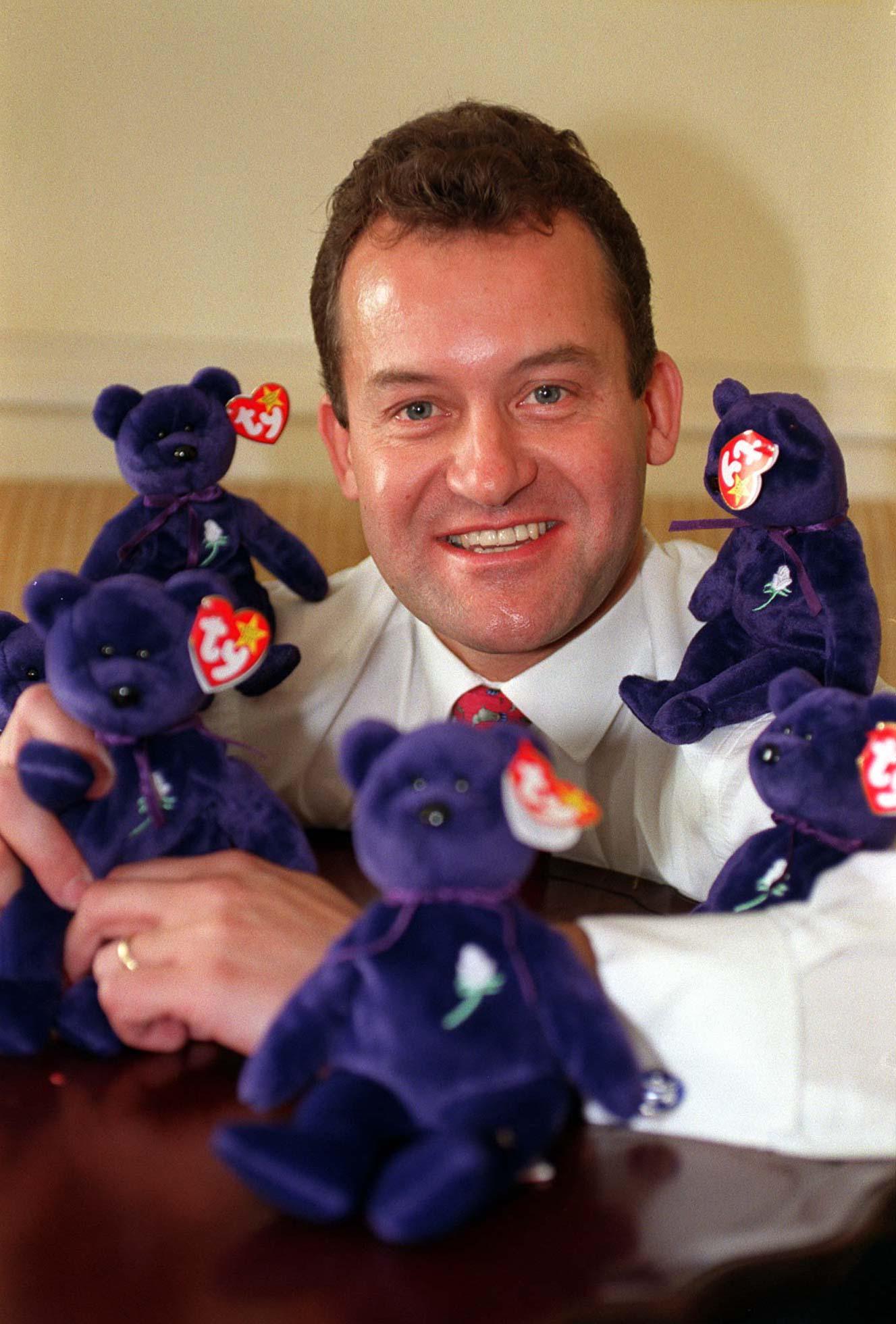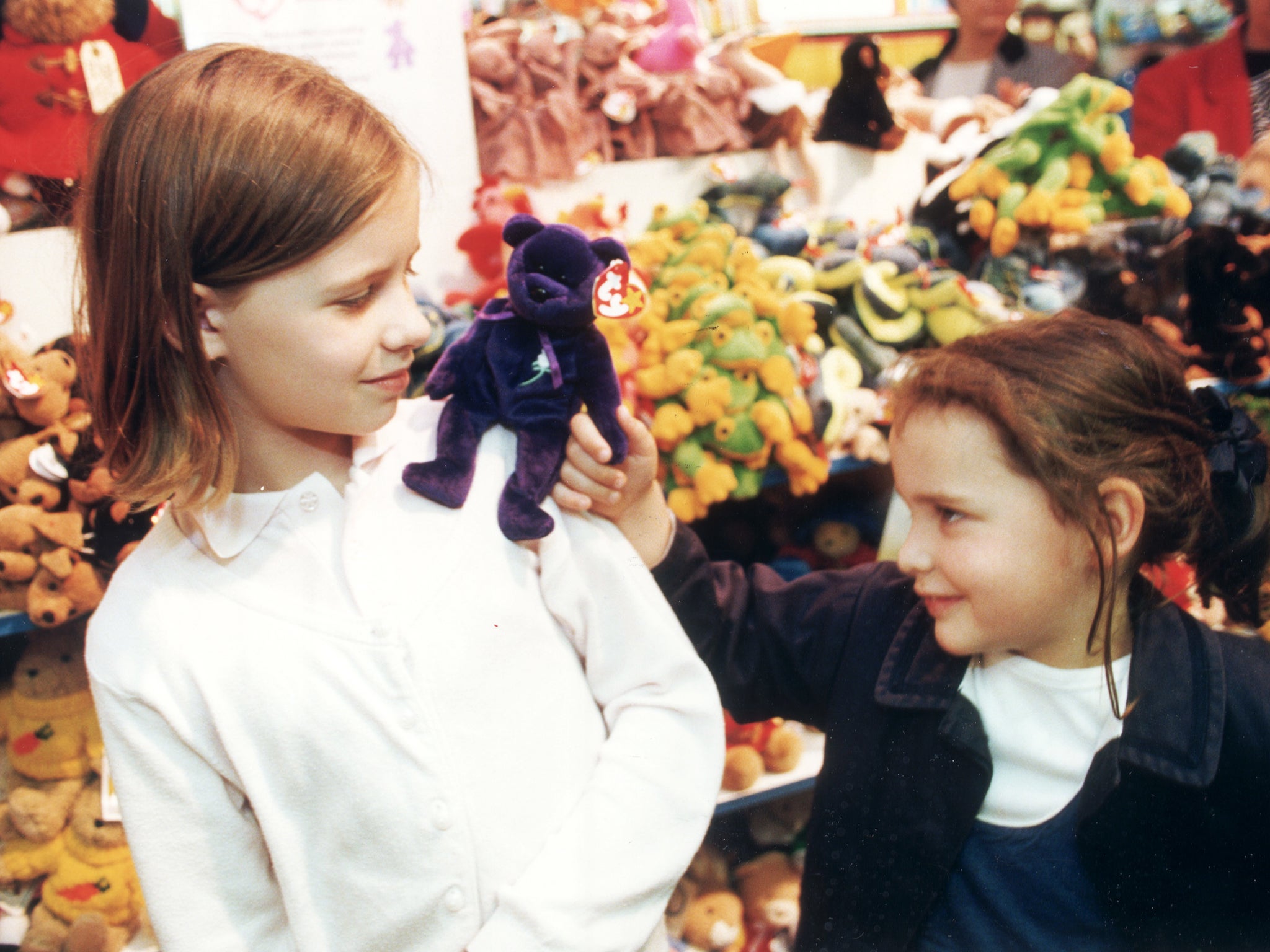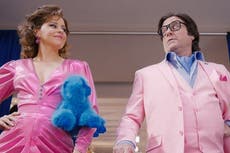The Independent's journalism is supported by our readers. When you purchase through links on our site, we may earn commission.
The Princess Diana Beanie Baby led to the strangest toy craze of the Nineties: ‘It was like the crown jewels!’
Released weeks after Diana’s death, the commemorative bear was speculated to one day be worth thousands. It didn’t happen. Katie Rosseinsky speaks to collectors and experts about the Beanie Baby fad of the Nineties and one of the brand’s most prized – if completely deranged – variations


In the winter of 1997, Katie Ford received a very special Christmas gift: a purple Beanie Baby teddy with a small white rose on its chest and a ribbon around its neck. Its name was Princess, in tribute to Diana, who had died just a few months before. “I was probably eight at the time, and my nan got hold of one for me,” explains Katie, now a 34-year-old vet based in Manchester. “I think she was more competitive about finding one than I was.” Her grandma, she explains, “was a frequent customer at the local Beanie shop”; she had accumulated so many “tokens” through purchasing Beanies for her grandchildren that she qualified to “go into a ballot to have a chance to get a Diana bear”.
As strange as it might seem more than 25 years later, a cuddly toy created to mourn the untimely passing of the People’s Princess was in serious demand (“I coveted her,” one 31-year-old friend admits when I canvass my millennial peers for Princess anecdotes). In the late Nineties, Beanie Babies were a bona fide phenomenon, and Diana’s tragic death coincided with the peak of the boom. The strange story behind Beanie-mania is now the focus of Apple TV+’s film The Beanie Bubble, which stars Zach Galifianakis as the brand’s idiosyncratic founder Ty Warner.
“I remember being told [the bear] was really special,” says PR consultant Lauren Cesi, who picked up a Princess Beanie at a specialist collector’s shop in Wales on a family holiday, “alongside a little tag protector to make sure the label didn’t get bent – it was like the crown jewels!” Not all Princess bears fared quite so well. “I have a strange recollection that it was somehow accidentally dropped in the toilet,” says The Independent’s arts editor Jessie Thompson. “The tag went a bit fuzzy – I was so upset that my dad had to redraw the label with my gold gel pen.” Why did any damage to that tag seem so catastrophic? “I thought [Princess] was going to make my fortune,” Jessie says.
The Beanie boom was rooted in a collective conviction (or delusion): that if the bears were kept in pristine condition, these unassuming creatures would one day skyrocket in value, potentially earning their owners a fortune. Warner’s simple but ruthlessly effective marketing strategy was to make customers believe that certain Beanies would be available for just a short window of time before they were “retired”. The company “used scarcity and exclusivity to create a sense of urgency and desire among consumers”, explains The Good Play Guide founder Dr Amanda Gummer, who has worked in toy research for more than 20 years. “Collectors quickly caught on to the rarity of specific designs,” she adds, which “fuelled a frenzy, with customers scrambling to obtain the most coveted pieces”.
A group of mums based in Chicago became consumed by a completist need to bag every Beanie Baby in existence, prompting a resale market to spring up on the internet, which was then in its infancy. Warner’s extreme perfectionism only fuelled this. The entrepreneur kept making tiny tweaks to improve his earliest designs, prompting fans to seek out (and pay vast sums for) these rarer variants.
When word got out about how much money could potentially be made, everyone wanted to get in on the game. By 1998,The New York Times reported that these $5 toys were being re-sold “for up to 1,000 times their original retail prices”. That year, Ty’s sales exceeded $1.3bn, and Beanies accounted for 10 per cent of total sales made on eBay. Even kids had some vague awareness of their toys’ potential value. Katie used to keep her “rare” Beanies in plastic boxes for protection. “I’m not sure I had much concept of money aged eight, but I felt very lucky to own [Princess],” she says. Once, she attended a valuation event at a local Beanie store with a special display case of Ty Happy Meal toys from McDonald’s. “I think they valued [it] at £500 at the time.”
Everyone wants it at the same time, everyone’s clamouring to get it, but the peaks for these are typically quite short-lived
Ty didn’t sell to chain stores, only to dedicated toy shops, which only helped further the mystique. “Information about new launches went direct to Beanie sellers, so you would only find out about new releases from local stores and fairs, rather than from the big corporation,” explains 33-year-old former collector Adam Brannon, now a senior content strategist at digital marketing agency Herd. “You couldn’t buy Beanie Babies online at the time, so it was a case of visiting your local Beanie store and hoping they had your chosen product in stock.” As Dr Gummer puts it, “the thrill of the hunt for elusive Beanie Babies became an addictive game”.
Another clever tactic was to release designs linked to a specific location or cultural moment, “usually something really landmark in terms of events or timings”, notes Toy World magazine’s editor Rachael Simpson-Jones. To coincide with the US presidential election in 1996, Ty launched three toys: a Democratic blue donkey called Lefty, a Republican red elephant called, you guessed it, Righty, and a stars-and-stripes bear called Libearty. UK customers could buy the exclusive Britannia bear, which Adam and his mum eventually acquired “for about £70 or £80” at a Beanie fair in Scarborough, North Yorkshire – an event “absolutely full of ‘proper’ collectors with thousands of pounds to spend”. American fans were desperate to get their hands on Britannia, too: cue tales of US tourists returning from trips across the Atlantic with suitcases full of bears to re-sell. According to The New York Times, this spurred Ty on “to register its trademark with customs officials, so they could confiscate the toys from would-be ‘importers’.”
Released in October 1997, the Princess bear was another attempt to “capture a moment in time”, Simpson-Jones says – and one that would certainly appeal to the all-important mum market. Proceeds would go to the Diana Memorial Fund and, at first, Ty allowed each retailer to order just 12 Princess Beanies for each store, creating that all-important sense of scarcity. Demand was so high that some retailers inflated their prices: a Washington Post article dated two months after Princess’s debut claimed that the bear was on sale for $350 at a kiosk at the Pentagon Centre mall in Arlington, Virginia. “It was crazy,” Becky Estenssoro and Karen Boeker, the founders of Beanie authentication service True Blue Beans, recall. “We saw them selling as high as $1,000 for a while until more supply came in.” Many shops held lottery-style events to raffle off their bears for charity.

If the initial prices were so high, Beanie fans reasoned, then surely Princess could command an even higher value on the secondary market. What they didn’t know was that Ty would churn out millions of purple teddies the following year, each bearing a mawkish memorial rhyme on the label. Very few of the apparently “rare” Beanie Babies were actually rare at all. The much-vaunted scarcity was all sleight of hand, with the aim of making mass-produced toys seem more desirable.
Perhaps we should have seen through the illusion all along – because “there’s quite a big difference between something being ‘scarce’ and something being a craze,” as Giana Eckhardt, professor of marketing at King’s Business School, explains. Something timeless, like a Hermes Birkin bag, with its infamous waiting list, “is an example of scarcity being a real asset to a brand”, she notes. “It’s only ever going to appeal to a particular niche of people,” she adds, so only a few are made, but it’s timeless and retains its value. Compare that to a “fad or craze” like Beanie Babies, she says. “Everyone wants it at the same time, everyone’s clamouring to get it, but the peaks for these are typically quite short-lived.”
In 1999, it became clear that the Beanie bubble was about to burst when Ty announced that it would be taking several toys off shelves – only for the news to barely cause a ripple in the resale community. This prompted collectors to freak out and flood eBay with their once-precious plushies, making it even clearer just how commonplace these products were. Ty went a step further, proclaiming that all Beanies would be retired at the end of 1999 (an event marked by the release of the apocalyptic “The End” bear, naturally). But even these drastic measures couldn’t buoy the market.
Beanie boom time was over, although the company would later reverse its dramatic announcement. These days, the toys are no longer a pop culture phenomenon, but they certainly haven’t gone extinct. Ty’s products “are still best-sellers”, Toy World’s Simpson-Jones says. Last year, the company released a Paddington Beanie Boo (essentially a big-eyed Beanie Baby) that was “hugely successful”, in part thanks to the late Queen’s Paddington Bear sketch at the Platinum Jubilee concert. “That sold out almost overnight in some stores,” she notes.
The myth that former Beanie collectors might be sitting on a goldmine (or storing one in their parents’ attic) also still persists – and the legend clings to the Princess teddy with particular fervour. That might be because TV shows like The Crown and films like Spencer have caused a younger generation to embrace Diana. “She’s having a moment again,” Eckhardt notes. But it’s also thanks to a handful of overly optimistic listings on eBay, where one absolute chancer is currently trying to sell a purple bear for £200,000 (a listing on the auction site, of course, is set by the seller and doesn’t necessarily correspond to an item’s actual value). The True Blue Beanies team recall one influential news story about a couple buying a Princess at a UK car boot sale for £10, only to be told it was worth thousands. “The people who told the buyer [that price] had seen the ‘fake sales’,” they note, referring to those suspicious online listings, “and just assumed it was correct information.” Listings and news stories like these create a feedback loop of hype.

According to TyCollector.com, a trusted site run by long-time collectors Leon Schlossberg and his daughter Sondra, one of the rarest Princess variations is an Indonesian-made bear filled with PVC pellets and with no spacing in the charity details listed on the all-important tag – and this tends to sell for between $125 and $170. The most common, Chinese-made Princesses with a space on the tag, they report, go for between $5 and $7 (between £4 and £5.50, approximately). So for all its nostalgic appeal, your Princess toy will probably barely cover a Pret lunch; it certainly won’t alchemise into a house deposit.
These days, Lauren admits, she’s “almost certain [the toys] only have sentimental value”. Her once-precious Princess Beanie is still at her parents’ house, where it now “occasionally gets terrorised by my own children”; she’d “sell it in a heartbeat if it was worth anything”. And Adam came face to face with this reality while on holiday in the Isle of Wight this year, where he found a shop selling original Beanies. All of them, including “some of the ‘rarer’ limited edition bears” were on sale for about £5 or £6, “much to my disappointment… How times change”. His collection (including the purple bear) is still “in a box in my mum and dad’s loft in Yorkshire”; on his next visit, he plans to dig it out “and have a look through all the memories with my mum. We’ll probably laugh at the ridiculous amount of money spent on them at the time, to be honest.”
‘The Beanie Bubble’ is streaming on Apple TV+
Join our commenting forum
Join thought-provoking conversations, follow other Independent readers and see their replies
Comments


Bookmark popover
Removed from bookmarks